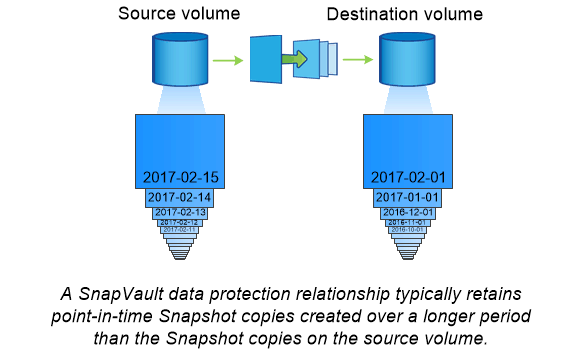SnapVault archiving
 Suggest changes
Suggest changes


The SnapMirror license is used to support both SnapVault relationships for backup, and SnapMirror relationships for disaster recovery. Beginning with ONTAP 9.3, SnapVault licenses are deprecated, and SnapMirror licenses can be used to configure vault, mirror, and mirror-and-vault relationships. SnapMirror replication is used for ONTAP-to-ONTAP replication of snapshots, supporting both backup and disaster recovery use cases.
SnapVault is archiving technology, designed for disk-to-disk snapshot replication for standards compliance and other governance-related purposes. In contrast to a SnapMirror relationship, in which the destination usually contains only the snapshots currently in the source volume, a SnapVault destination typically retains point-in-time snapshots created over a much longer period.
You might want to keep monthly snapshots of your data over a 20-year span, for example, to comply with government accounting regulations for your business. Since there is no requirement to serve data from vault storage, you can use slower, less expensive disks on the destination system.
As with SnapMirror, SnapVault performs a baseline transfer the first time you invoke it. It makes a snapshot of the source volume, then transfers the copy and the data blocks it references to the destination volume. Unlike SnapMirror, SnapVault does not include older snapshots in the baseline.
Updates are asynchronous, following the schedule you configure. The rules you define in the policy for the relationship identify which new snapshots to include in updates and how many copies to retain. The labels defined in the policy (“monthly,” for example) must match one or more labels defined in the snapshot policy on the source. Otherwise, replication fails.

|
SnapMirror and SnapVault share the same command infrastructure. You specify which method you want to use when you create a policy. Both methods require peered clusters and peered SVMs. |



